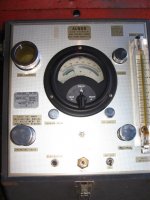Looking for the actual usage of this thing, and age. I'm pretty sure there are some collectors of old equipment here.
I know what galvanometers do, been using them for decades.
The question is what THIS one was for. It's a bit special, has a box that would allow it to be portable, and is simple and easy to fix, as it would need to be if used out in the sticks back when horse travel was the typical means.
Simple silk thread suspension, adjustable for height, thread easily replaceable. No bearings, one moving part. Two magnifying lenses for observing the pointer vs two reference lines at 180 degrees.
Unlike most, it has two damper vanes on the pointer, suggesting it is not intended for use with standard cells, since with cells you only hit the "key" for a very short time, watching for a "twitch" of the pointer. the vanes would limit that, suggesting it is more for a DC balance other than a standard cell.
Won't know the sensitivity until I get some silk thread of the same thickness as what is left. It is an "astatic" type, improved over the old "tangent" type that was affected by the earth's magnetic field.



View of the pointer

The top cover, with "travel lock" for pointer. Loop on screw is for the thread, matching loop on pointer.

I know what galvanometers do, been using them for decades.
The question is what THIS one was for. It's a bit special, has a box that would allow it to be portable, and is simple and easy to fix, as it would need to be if used out in the sticks back when horse travel was the typical means.
Simple silk thread suspension, adjustable for height, thread easily replaceable. No bearings, one moving part. Two magnifying lenses for observing the pointer vs two reference lines at 180 degrees.
Unlike most, it has two damper vanes on the pointer, suggesting it is not intended for use with standard cells, since with cells you only hit the "key" for a very short time, watching for a "twitch" of the pointer. the vanes would limit that, suggesting it is more for a DC balance other than a standard cell.
Won't know the sensitivity until I get some silk thread of the same thickness as what is left. It is an "astatic" type, improved over the old "tangent" type that was affected by the earth's magnetic field.



View of the pointer

The top cover, with "travel lock" for pointer. Loop on screw is for the thread, matching loop on pointer.





